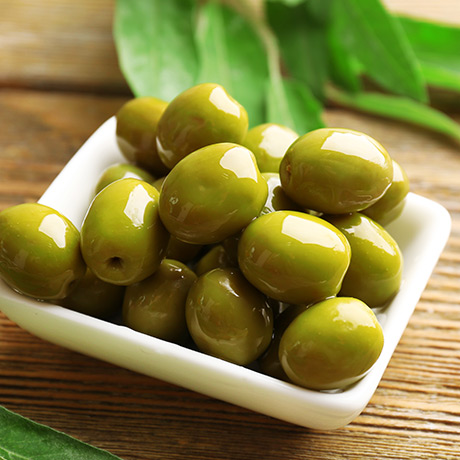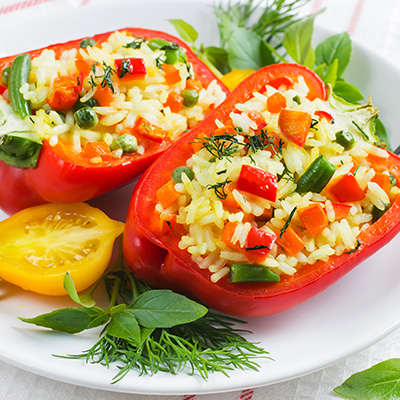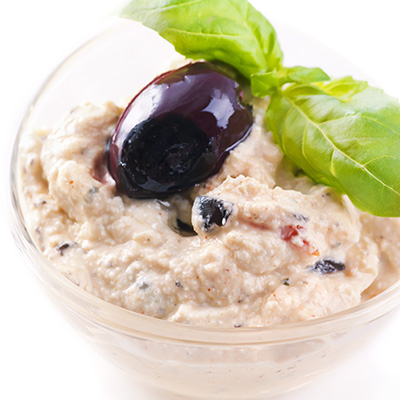- Strawberries
- Cook With Apples
- Grapes
- Grapefruit
- Lemons
- Cabbage
- Asparagus
- All About Bulb Vegetables
- All About Cruciferous Vegetables
- Squash
- All About Root Vegetables
- The Gift of Spice
- Thyme
- Basil
- Raspberries
- All About Tuber Vegetables
- Marjoram / Oregano
- Lemongrass / Citronella
- All Our Fruits, Vegetables and Fresh Herbs
- All About Exotic Fruits
- All About Legumes
- Cooking Pears: Three Inspirational Methods
Flavour Boosters: Olives and Hot Peppers

There’s no simpler way to add flavour to a dish than with these two versatile foods. Olives and hot peppers each have many varieties to choose from, all of which offer distinct flavours and delicious possibilities. They help to liven up everything from sauces, dips, salads, sandwiches and so much more.
Whole olives
The olive is an essential ingredient in Middle Eastern and Mediterranean cuisines. It’s one of the oldest cultivated fruits said to be originated from Crete some 5,000 years ago. The fruit comes from the olive tree which is an exceptionally long-living plant recognized the world over as a symbol of peace and wisdom.
Characteristics
The olive tree can reach five metres in height and produce a multitude of fruit according to the variety. Green olives are picked just before they change to black, while black olives are not picked until they reach maturity. Olives are inedible when harvested and must be first steeped and treated.
There are hundreds of different types of olives, not to mention the many ways and methods used to process the fruit. Olives are available in brine, dried, spiced, sliced or stuffed.
Culinary tips and advice
- Olives are excellent with pasta, sauces, pizza, slow-cooked dishes, salads and sandwiches.
- Olives are the main ingredient in tapenade, a delicious, salty spread. To make tapenade, simply chop the olives of your choice finely and add chopped anchovies, garlic, olive oil, lemon juice and capers. Serve with crackers, toast, stuffed in mushrooms, with pasta, fowl, fish or grilled meats.
- Whole olives are often served with cocktails, such as martinis.
Availability
Different varieties of olives are available year-round at your local Metro supermarket.
Nutritional value
The olive contains monounsaturated fat, well-known for its beneficial effects on the cardiovascular system. Two black marinated olives contain only eight calories and 0.9 g of lipids.
Storage life
Olives can be stored for up to one year in a sealed container. Dried olives do not last as long and should be placed in the refrigerator after opening.

Hot Peppers (Chilli Peppers)
Originating from Central and South America, hot peppers belong to the solanaceae family as do eggplants, potatoes, tomatoes, tree tomatoes, and ground cherries. The largest varieties of hot peppers can be found in Mexico and the Antilles.

Characteristics
The hot pepper is a fleshy pod that grows on plants that can reach 1.5 metres in length. There are a dozen different types of hot peppers that vary in colour, shape and capsaicin content, the active substance that gives peppers their spicy, hot taste.
The hot pepper is more a spice than a vegetable. The main difference between hot peppers and sweet peppers is the high capsaicin content in hot peppers. This is very, very strong oil that can burn the eyes and the mouth, so hot peppers must be handled with precaution. Capsaicin is found primarily in the white pith that run down the inside of a pepper, and to a lesser extent, the seeds.
Hot pepper varieties
- Cayenne — A long, thin, red pepper, measuring 4-10 centimetres in length. It has a bumpy surface. This pepper adds a wonderful fragrance to pasta sauces, Indian curries and Mexican dishes. Barometer: Medium to very hot.
- Cherry hot — Round like a plump cherry with a clear, red, shiny skin. This very hot pepper can be used in salads, guacamole, relish and chili. Also great in pasta sauce. Barometer: Medium to very hot.
- Finger hot — Pale to dark green or red, it has a long tapered shape that makes it look like a finger. Its skin is bumpy. This very hot pepper can be used in salads, guacamole, Mexican sauces and salsa. Barometer: Medium to very hot.
- Long hot — Dark green, long, bumpy, and slightly deformed, it has a shiny surface. This hot pepper can be used in guacamole, chili, potato salad or pasta. Barometer: Medium to very hot.
- Habanero — One of the hottest peppers in the world, it is 20-50 times stronger than the jalapeno. It’s shaped like a lantern with a centre that turns orange when ripe. It’s has a fruity taste with a distinct dried apricot scent. Barometer: Very hot.
- Yellow banana — Long, yellow pod with a smooth surface. Excellent for spicing up a sandwich. Simply slice the pepper in half, remove the seeds and the membrane, and serve raw in the sandwich. Barometer: Mildly hot.
- Jalapeño — Dark green, short, pointed pepper with smooth skin. This very hot pepper can be served in salads, guacamole, pasta sauces and made into relish. Barometer: Medium to very hot.
- Serrano — Smooth, dark green, slender and tapered. This is a very hot pepper and great for Mexican sauces, guacamole or in Chinese dishes. Barometer: Medium to very hot.
- Tabasco — Not surprisingly, the Tabasco originates from the state of Tabasco, Mexico where peppers are used to make the famous sauce of the same name. Small, very strong fruit measuring 5 cm in length when ripe, changes colour from white, to yellow, to orange and finally red. This very hot pepper can be used in Mexican sauces, guacamole or in Chinese dishes. Barometer: Medium to very hot.
Culinary tips and advice
- Select a firm hot pepper that is shiny, well formed, without bruises or blemishes.
- Before using, slice the pepper in half then remove the membrane and the seeds.
- To reduce the stinging power of the hot pepper, dip it in cold water with a bit of vinegar.
- It’s very important to wash your hands after handling hot peppers. This will help to prevent the oils from getting in your eyes, which can be very painful.
- Hot peppers can be eaten raw or cooked, in salads, tacos, burritos, sautés, pasta sauces, curries, tajines and other slow-cooked dishes. Milder hot peppers can be stuffed; just halve, hollow out and fill with cream cheese and herbs.
Availability
Hot peppers are available year-round in the produce section of your local Metro supermarket.
Nutritional value
Hot peppers contain more Vitamin C than oranges. However, since only small amounts are used in recipes and they are usually cooked, the Vitamin C content is diminished.
Storage life
Unwashed hot peppers can be refrigerated for one week in the crisper drawer or in a plastic bag. Pieces of hot pepper freeze well without blanching.













